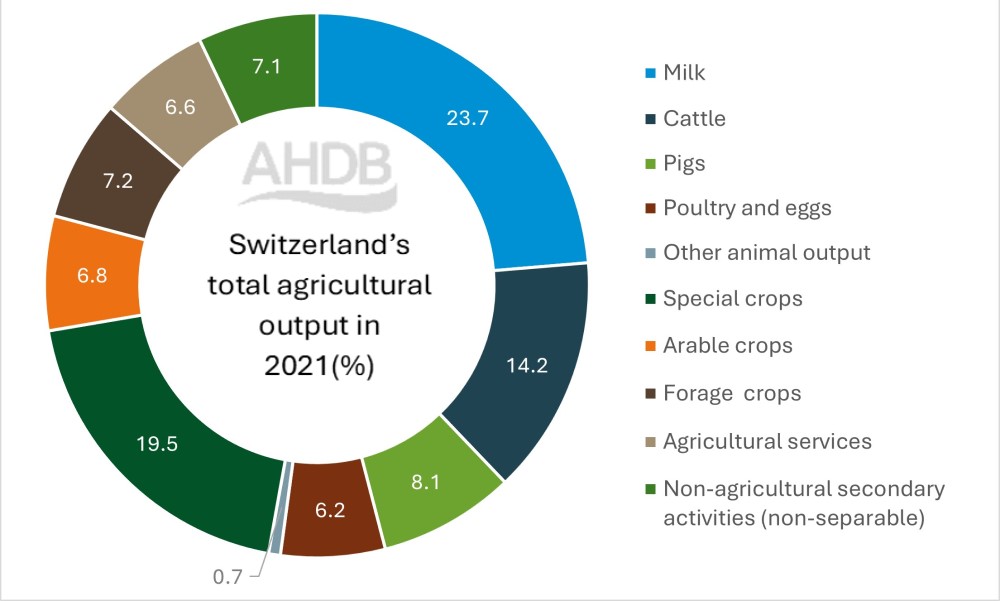- Home
- Lamb trade and production in Switzerland
Lamb trade and production in Switzerland
Swiss consumers favour high standards of farming and are willing to pay premium prices to consume high-quality sheep products. Since UK sheep farming boasts some of the highest health and welfare stats globally, we are well placed to grow our exports of sheep meat into Switzerland.
Overview
The sheep sector plays a less prominent role in comparison to other red meat protein sources in Switzerland, making up a small percentage of the industry. In 2022, the number of sheep farmers in Switzerland sat at 79,691 and the sheep population for 2023 was 4,604,572.
Within Switzerland’s total agricultural output, sheep production falls within the ‘other animal output’ category, which forms just 0.7% of outputs (Figure 1).
Figure 1. Switzerland’s total agricultural output in 2021

Source: FSO – Economic accounts for agriculture
The industry has a varied structure, but it is dominated by alpine-style farming. Milk breeds of sheep play a minor but growing role within the Swiss sheep industry. However, sheep production remains minimal in comparison to the UK and can be considered a niche business. In 2022, domestic production fell by 3% (3,748 tonnes).
Production is mainly extensive, with alpine sheep farming being the norm due to the terrain. This meets the demands of Swiss consumers, with the growth and popularity of organic food production continually increasing. Many alpine farmers face challenges due to large carnivores in the Swiss Alps posing a threat to their stock.
Imports and exports
Imports of sheep meat into Switzerland for 2022 were 8,293 tonnes, down by 6% compared with 2021. Of this, 92% was imported from New Zealand, the UK, Ireland and Australia. The rest was sourced from EU countries and South America.
Most sheep meat products produced in Switzerland are consumed domestically. Exports of sheep meat remain low, with small amounts exported to Germany in 2022.
Table 1. Annual trade and production, comparison between Switzerland and the UK (2022)
| Switzerland | UK | |
|---|---|---|
| Production (t) | 3,748 | 238,000 |
| Imports (t) | 5,193 | 49,774 |
| Exports (t) | 1 | 60,632 |
Consumption
Despite red meat consumption in Switzerland remaining stable, lamb consumption is in decline. It experienced the largest decline in consumption within the Swiss red meat sector in 2022, falling by 6.1% to 8,939 tonnes. Despite lamb being perceived as a niche product in Switzerland, cuts such as saddle of lamb, lamb chops and legs of lamb are increasing in popularity.
Swiss consumers prefer high-value, high-quality products, with provenance playing a key role within their food choices. Switzerland has strict animal health and welfare standards, similar to the UK sheep industry, with mostly outdoor, pasture-based systems.
The Swiss farming sector has also adopted the use of farm assurance labelling, with “Suisse Garantie” branding being used to label domestically produced products. These high standards can be seen throughout Swiss farming practices and are highly regarded by Swiss consumers.
Back to
Hubpage: The impact of a UK–Switzerland Free Trade Agreement on UK agriculture
Continue reading about the UK–Switzerland FTA
- Introduction
- Trade between the UK and Switzerland at a glance
- Switzerland trade and production
- Consumer demand: Is there a market to export more UK red meat and dairy to Switzerland?
- Agricultural policy in Switzerland
- Switzerland's Free Trade Agreements
- Economic modelling of the beef, sheep, dairy and pork sectors (coming soon)


